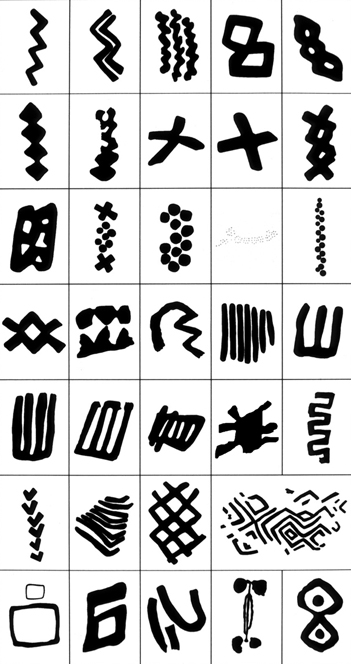
















Introduction
Apart from the figurative representations, various ornaments, signs and symbols occur: single strokes and rows of strokes, lattice patterns, zigzag and wavy lines, geometric patterns, meanders, flowers, garlands of flowers, crosses and rows of flowers and crosses, circles, chevrons, dots, rhomboid and textile patterns as well as sexual (?) and cosmic (?) symbols (?), in addition numerous hands and occasionally even feet (2).
These ornaments are mostly used to fill the open spaces between figurative depictions so that the question arises whether they are just to be understood as decorative elements or whether they had a meaning of their own. The fact that there are pictures consisting exclusively of ornaments and signs, such as the rock picture of Damlıyurt or some fields of the pictures in the ‘rock chamber’ of Balıktaş (see above), speak in favour of the latter assumption. Thus the meanders, wavy and zigzag lines could be interpreted as symbols for water. The depictions of hands are perhaps to be understood as the signatures of persons who visited the sites with the rock paintings and participated in the rites celebrated here.
A large part of the ornaments and signs occurring in the paintings of the Latmos are part of a well-known stock of forms in rock pictorial art, some of them, such as the meander, the strokes and rows of strokes or hand-prints can be traced back to the Palaeolithic era. Unusual, however, are the textile patterns which have been found repeatedly in Latmic pictures, above all on the loincloths of female figures. They have also been found as an individual motif, such as in the rock painting of Cayırlık Mevkii (see above). Comparable patterns in other rock paintings are extremely rare.
Apart from the figurative representations, various ornaments, signs and symbols occur: single strokes and rows of strokes, lattice patterns, zigzag and wavy lines, geometric patterns, meanders, flowers, garlands of flowers, crosses and rows of flowers and crosses, circles, chevrons, dots, rhomboid and textile patterns as well as sexual (?) and cosmic (?) symbols (?), in addition numerous hands and occasionally even feet (2).
These ornaments are mostly used to fill the open spaces between figurative depictions so that the question arises whether they are just to be understood as decorative elements or whether they had a meaning of their own. The fact that there are pictures consisting exclusively of ornaments and signs, such as the rock picture of Damlıyurt or some fields of the pictures in the ‘rock chamber’ of Balıktaş (see above), speak in favour of the latter assumption. Thus the meanders, wavy and zigzag lines could be interpreted as symbols for water. The depictions of hands are perhaps to be understood as the signatures of persons who visited the sites with the rock paintings and participated in the rites celebrated here.
A large part of the ornaments and signs occurring in the paintings of the Latmos are part of a well-known stock of forms in rock pictorial art, some of them, such as the meander, the strokes and rows of strokes or hand-prints can be traced back to the Palaeolithic era. Unusual, however, are the textile patterns which have been found repeatedly in Latmic pictures, above all on the loincloths of female figures. They have also been found as an individual motif, such as in the rock painting of Cayırlık Mevkii (see above). Comparable patterns in other rock paintings are extremely rare.











































